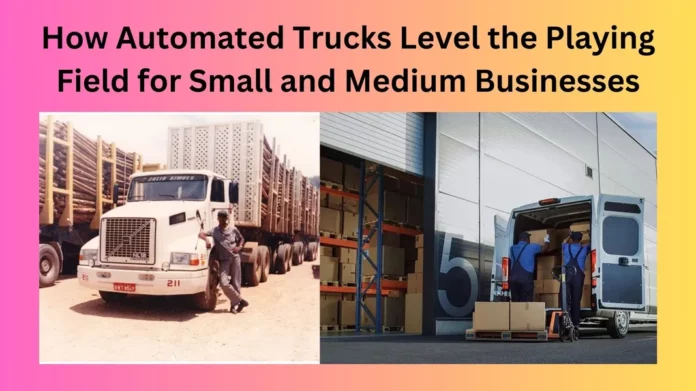In the dynamic landscape of modern business, staying ahead often requires embracing cutting-edge technology. One such game-changer is the advent of automated trucks, transforming the logistics industry and providing unprecedented opportunities for small and medium-sized businesses (SMBs).
This article explores the impact of automated trucks on leveling the playing field, empowering SMBs to compete with industry giants on a more equal footing.
The Rise of Automated Trucks:
1: The Technological Evolution
The introduction of automated trucks represents a significant leap forward in the evolution of transportation. From advanced sensors to artificial intelligence algorithms, these trucks are equipped with state-of-the-art technology that enables them to navigate and transport goods autonomously. This technological marvel is not only reshaping the logistics landscape but is also opening new doors for businesses of all sizes.
2: Navigating the Autonomous Highway
Automated trucks utilize a combination of GPS, LiDAR, and advanced cameras to navigate the roads seamlessly. This not only enhances safety but also optimizes routes, reducing transportation time and costs. For SMBs, this means quicker deliveries and improved efficiency, leading to a competitive edge in the market.
Benefits for Small and Medium Businesses:
1: Breaking Down Barriers
Automated trucks break down traditional barriers that often hinder the growth of SMBs in the logistics sector. These barriers, ranging from high operational costs to limited resources, are now being dismantled, allowing smaller players to stand shoulder to shoulder with industry giants.
2: Cost-Efficiency and Affordability
One of the most significant advantages of automated trucks for SMBs is the potential for cost-efficiency. While the initial investment may seem daunting, the long-term benefits outweigh the costs. These trucks reduce labor expenses, fuel costs, and the risk of human errors, making them a financially viable option for smaller enterprises.
3: Scalability and Flexibility
Unlike traditional logistics models that require a considerable workforce, automated trucks offer scalability and flexibility. SMBs can adapt to changing market demands more effectively, scaling operations up or down without the complexities associated with human resource management.
Challenges and Solutions:
1: Navigating the Roadblocks
While the benefits are evident, it’s crucial to acknowledge the challenges associated with the adoption of automated trucks. Understanding these challenges is the first step toward finding innovative solutions that ensure a smooth transition for SMBs.
2: Technological Concerns and Training
The integration of automated trucks requires a workforce skilled in handling and maintaining advanced technology. SMBs may face challenges in training their employees to adapt to this technological shift. However, investing in comprehensive training programs can bridge this gap, ensuring a seamless transition.
3: Regulatory Compliance and Safety Standards
The regulatory landscape for automated trucks is still evolving. SMBs must stay abreast of changing regulations and invest in safety measures to ensure compliance. Collaborating with regulatory bodies can also aid in shaping policies that consider the unique needs of smaller businesses.
The Human Touch in Automated Logistics:
1: Balancing Technology and Human Expertise
While automation streamlines operations, it’s essential to emphasize the continued importance of human expertise in logistics. Automated trucks should be viewed as tools that augment human capabilities rather than replace them entirely.
2: Empowering the Workforce
The integration of automated trucks can empower the existing workforce rather than displacing it. By focusing on upskilling employees to handle the technological aspects, SMBs can create a harmonious blend of human intelligence and artificial intelligence, ensuring a more robust and adaptive logistics ecosystem.
Conclusion:
In conclusion, the rise of automated trucks is a transformative moment for SMBs in the logistics industry. These technological marvels are not just tools for large corporations but are leveling the playing field, enabling smaller enterprises to compete more efficiently. By embracing automation, SMBs can redefine their logistics strategies, reduce costs, and enhance overall competitiveness.
Frequently Asked Questions:
1. Q: Are automated trucks only suitable for large logistics companies?
- A: No, automated trucks offer scalability and affordability, making them a viable option for small and medium-sized businesses as well.
2. Q: How do automated trucks improve efficiency for SMBs?
- A: Automated trucks optimize routes, reduce operational costs, and enhance overall efficiency, allowing SMBs to compete more effectively in the market.
3. Q: What challenges do SMBs face in adopting automated trucks?
- A: Challenges include technological concerns, training requirements, and staying compliant with evolving regulatory standards.
4. Q: Can automated trucks completely replace human involvement in logistics?
- A: No, automated trucks should be viewed as tools that augment human expertise, creating a synergistic relationship for optimal efficiency.
5. Q: How can SMBs ensure a smooth transition to automated logistics?
- A: SMBs can invest in employee training programs, stay informed about regulatory changes, and emphasize the collaborative role of humans and technology in logistics.















